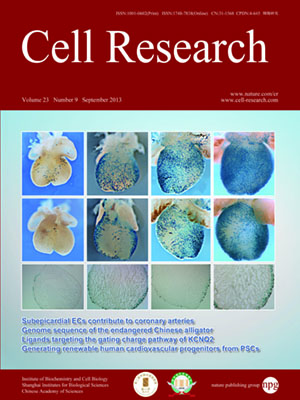
Volume 23, No 9, Sep 2013
ISSN: 1001-0602
EISSN: 1748-7838 2018
impact factor 17.848*
(Clarivate Analytics, 2019)
Volume 23 Issue 9, September 2013: 1133-1146
ORIGINAL ARTICLES
Drosophila Myc integrates multiple signaling pathways to regulate intestinal stem cell proliferation during midgut regeneration
Fangfang Ren1,4,*, Qing Shi1,*, Yongbin Chen2, Alice Jiang1,5, Y Tony Ip3, Huaqi Jiang1 and Jin Jiang1,2
1Department of Developmental Biology, University of Texas Southwestern Medical Center at Dallas, Dallas, TX 75390, USA
2Key Laboratory of Animal Models and Human Disease Mechanisms of Chinese Academy of Sciences & Yunnan Province, Kunming Institute of Zoology, Chinese Academy of Sciences, 32 Jiaochang Donglu, Kunming, Yunnan 650223, China
3Program in Molecular Medicine, University of Massachusetts Medical School, Worcester, MA 01605, USA
4Current address: Wuxi AppTec, Wuxi, Jiangsu 214092, China
5Current address: Department of Biochemistry and Cell Biology, Rice University, Houston, TX 77251, USA
Correspondence: Jin Jiang(Jin.Jiang@utsouthwestern.edu)
Intestinal stem cells (ISCs) in the Drosophila adult midgut are essential for maintaining tissue homeostasis, and their proliferation and differentiation speed up in order to meet the demand for replenishing the lost cells in response to injury. Several signaling pathways including JAK-STAT, EGFR and Hippo (Hpo) pathways have been implicated in damage-induced ISC proliferation, but the mechanisms that integrate these pathways have remained elusive. Here, we demonstrate that the Drosophila homolog of the oncoprotein Myc (dMyc) functions downstream of these signaling pathways to mediate their effects on ISC proliferation. dMyc expression in precursor cells is stimulated in response to tissue damage, and dMyc is essential for accelerated ISC proliferation and midgut regeneration. We show that tissue damage caused by dextran sulfate sodium feeding stimulates dMyc expression via the Hpo pathway, whereas bleomycin feeding activates dMyc through the JAK-STAT and EGFR pathways. We provide evidence that dMyc expression is transcriptionally upregulated by multiple signaling pathways, which is required for optimal ISC proliferation in response to tissue damage. We have also obtained evidence that tissue damage can upregulate dMyc expression post-transcriptionally. Finally, we show that a basal level of dMyc expression is required for ISC maintenance, proliferation and lineage differentiation during normal tissue homeostasis.
10.1038/cr.2013.101
FULL TEXT | PDF
Browse 2816


